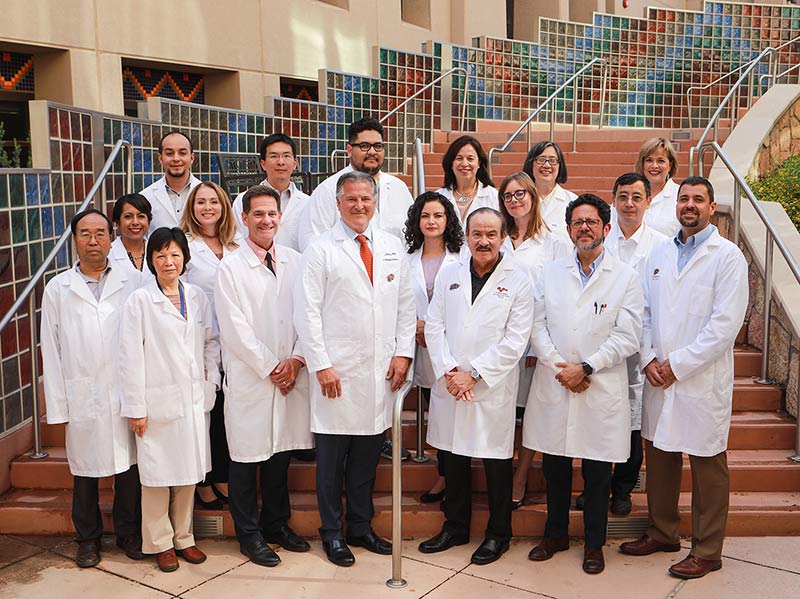UTEP Receives $19M to Study Cancer Affecting Mexican-Americans
Last Updated on October 14, 2019 at 12:00 AM
Originally published October 14, 2019
By Darlene Barajas
UTEP Communications
The University of Texas at El Paso's Border Biomedical Research Center (BBRC) will accelerate its quest to understand and identify the reasons for Hispanic cancer health disparities and its ultimate impact on the people of the Paso del Norte region thanks to a five-year, $19.2 million grant from the National Institutes of Health (NIH).

The University of Texas at El Paso's Border Biomedical Research Center (BBRC) will accelerate its quest to understand and identify the reasons for Hispanic cancer health disparities and its ultimate impact on the people of the Paso del Norte region thanks to a five-year, $19.2 million grant from the National Institutes of Health (NIH). Video by UTEP Communications
This grant will provide significant research funds for UTEP cancer scientists to understand better the molecular mechanisms, and possible environmental and lifestyle factors that contribute to this multifaceted disease. The researchers also will use those funds to expand UTEP’s cancer tissue “bank” that is used to study and identify possible new drugs that might prove useful in cancer treatment strategies in our primarily Mexican-American population.
“The BBRC active research faculty, staff and students continue to perform incredible work in this area to find the cause and novel solutions to this deadly disease, which is now a leading cause of death among Hispanics,” said Robert A. Kirken, Ph.D., BBRC director and dean of the College of Science. “UTEP, in partnership with regional hospitals and institutions, is better positioned than ever before to fight these cancers through a combination of basic and clinical research studies, cutting-edge technologies, alongside healthcare providers, and community health workers.”
Kirken, the grant’s principal investigator, said the BBRC would utilize multiple approaches such as biomolecular research and behavioral and social science research to address this very critical issue. Through these efforts, UTEP is living up to its Carnegie R1 status as a University with very high research activity, he said.
“We are very excited about this type of research,” said Kirken, who added that the plan is to focus on certain cancers that are more prevalent, less responsive to treatment, and display higher relapse rates in our population. Those include breast, cervical, prostate, liver, and pediatric leukemia. “We are confident our work will provide new insight into the genetic causes and new treatment strategies to effectively reduce and/or eliminate these cancers.”
One of the program’s more specific objectives through the grant is to propose an innovative strategy that would better define Hispanic cancers.
“The absence of a comprehensive Cancer Tissue Biorepository that reflects the prominent Mexican-American and Mexican-Hispanic populations of the El Paso-Juárez borderplex is a profound barrier for understanding the complexity of Hispanic cancer health disparities and for developing targeted therapeutic interventions,” said Michael Kenney, Ph.D., associate dean for research and the BBRC’s core facilities deputy director.
A separate social behavioral project will explore the potential barriers and facilitators in the use of the vaccine for the human papillomavirus (HPV) in the Paso del Norte region. This information could lead to tailored interventions that would increase acceptance of the HPV vaccine. With the new guidelines for HPV vaccinations, adults up to age 45 now can be vaccinated to protect themselves against multiple types of cancers.
BBRC scientists hope that their work will lead to new approaches and therapeutic strategies to address questions about cancers that afflict Hispanics, a population typically not included in clinical trials and research programs. This huge undertaking will require the community’s participation and the collaborations of local hospitals and physicians.
Armando Estrada, Ph.D., a postdoctoral research fellow in UTEP’s bioscience lab, said the program allows him to work with the community and train new student researchers who benefit from their work with the BBRC.
Estrada said these opportunities give UTEP graduates an edge when they apply for graduate or medical school.
“Traditionally, Hispanics have been underrepresented in research and I think this is a great building block for us to better understand which Hispanic disparities exist within these cancers,” Estrada said.
He said UTEP students who work in the BBRC have access to next generation sequencing that allows them to identify novel or previously unreported mutations within cancer. This could lead to research that can identify targets for future therapies and new medications that could be more effective with fewer side effects.